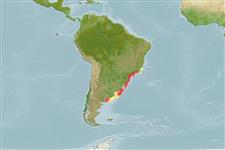Classification / Names
Common names from other countries
Main reference
Size / Weight / Age
Max length : 30.0 cm TL male/unsexed; (Ref. 6077)
Length at first maturity
Lm 13.0 range ? - ? cm
Environment
Marine; demersal; depth range 20 - 60 m (Ref. 27363)
Climate / Range
Subtropical, preferred 19°C (Ref. 107945); 20°S - 41°S, 65°W - 40°W
Distribution
Short description
Dorsal
spines
(total): 8;
Dorsal
soft rays
(total): 8;
Anal
spines: 2;
Anal
soft rays: 6. Body reddish dorsally, pinkish ventrally. Large blotch or band of jet black near tip of first dorsal fin. Three bands on second dorsal fin. Posterior median rays of caudal fin blackish, both lobes with indistinct bands. Pectoral and pelvic fins reddish. Anal fin rays pale pinkish, its membrane translucent, and its base milky white. Cheek and preopercular silvery white (Ref. 27363).
IUCN Red List Status (Ref. 115185)
Threat to humans
Harmless
Human uses
Fisheries: minor commercial
More information
ReferencesAquacultureAquaculture profileStrainsGeneticsAllele frequenciesHeritabilityDiseasesProcessingMass conversion
Tools
Special reports
Download XML
Internet sources
Estimates of some properties based on models
Phylogenetic diversity index
PD50 = 0.5625 many relatives (e.g. carps) 0.5 - 2.0 few relatives (e.g. lungfishes)
Trophic Level
3.5 ±0.41 se; Based on food items.
Resilience
Medium, minimum population doubling time 1.4 - 4.4 years (Assuming tm=2-4)
Vulnerability
Low to moderate vulnerability (29 of 100)
Price category
